Editorial
As promised (threatened?), this issue is a trifle slimmer than the issues of recent months. I really had a lot more material I'd have liked to present, but owing to the amount of work that has been poured into the Site Search Facility, it will have to wait. However I believe it's been more than worth it; only time will tell. Next to get the overhaul treatment will be the navigation panel (the yellow thing at the left). With luck, that will be completed in time for New Year.
November has also been a productive month for me in the shop with one engine completed, a second almost completed, and a third begun. The first two I can't share at this time, but the third—a Pepperell—will get a treatment of some kind in the near future.
Now, as they say, for the bad news. DSTC, our little research group, exists on government and industry funding. The government contribution is allocated in 7 year cycles, the current round of which will cease in 18 months time. We've just been informed that our bid for another round of funding has been unsuccessful, so it's highly likely that we'll be turning off the lights and all our scientists and engineers will be moving on to other challenges, yours truly included. That means that the small corner of our web servers that delivers these pages to you will go offline, taking the 5 GB of Model Engine News with it. I've no plan in mind yet on how to deal with that. Stay tuned...
Search Me
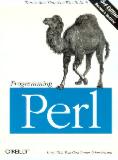
Last month, with a little gentle urging from Roger Schroeder (of Classic Model Engine Kit fame), I came to sad realization that this site was out of control, and had been for some time. Frequently when writing an article, I found myself using the Unix grep and find tools to locate some text on a page that I needed to create a hyperlink to. This was quite effective in quickly giving me a list of candidate file paths containing the "thing" I was searching for, so I figured that a similar, on-line facility should be able to function as the much needed site-searcher. Unfortunately this would require use of a CGI (common gateway interface) scripting language like Perl, and learning that language is something I've been diligently avoiding for years (the Engine Finder uses a 4 line Perl script which had been more than enough to frighten me off previously).
But it was obviously the most viable solution, regardless of how much I feared the underlying technology. So a week of learning and experimenting has now delivered an acceptable search facility, and confirmed my suspicions that in the context of my passion for maintainability, reliability, and scalability, Perl is probably the most dangerous language ever developed. Nevertheless, this month we see the first roll-out of the Site Search Facility that does the grep|find thang in greater depth, and formats the results into a nice hyperlinked page.
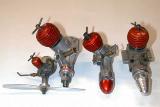
As the search engine started to come together, I started discovering atrocities within the web pages themselves—particularly the early ones, and frequently in non-displayable areas. This has led to a spate of page fix-ups so that when a page is located, the non-visible information can be extracted to create a hopefully useful list of "hits" that are sufficiently self-explanatory to enable intelligent user choices to be made. In particular, the Restorations Section and The Gallery have been significantly revised, creating thumbnails for images that had been embedded full size, and expanding on the text. It may be worth your while to give that corner of the attic another once-over.
The Site Search Page contains all sorts of extra information about how to use it and how it works. Read it if you feel an unexplained need for understanding Inverse Document Frequency Weighted Ranking, or ignore it and just charge in regardless. It's still being tweaked, and feedback is welcome, but at least the chance of delivering a searchable CD is now closer to reality. By the way, the site now contains 5 giga-bytes of text and pictures on disk. A lot of this is due to file allocation block size, so the actual space consumed is less. Hopefully the CD will be usable straight out of the box. If not, it will be an installer that chews up 5GB of your disk after the smoke clears.
Son of EZE
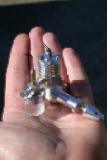
Around the middle of November, I received an email from Joe Webster who had just fired up his ML Midge for the first time. Joe did a super job of the little engine, adding neat little touches of his own, getting well and truly bitten by the engine building bug in the process. It had not been all plain sailing. Joe ended up replacing his liner and contra-piston before achieving success, measured as 9,200 RPM swinging a 6x3.5 Master airscrew on Aerodyne standard diesel fuel, with an air temperature of 47 degrees F for testing—brave man!
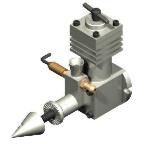
 Just as this issue was being put to bed, another email arrived from Joe. He had become attracted to the EZE Series of engines developed by Tom Crompton and published in the old series of Model Engine World. Being an accomplished CAD user, Joe decided to do an adaptation of the EZE all of his own. The rendered 3D image shows how it will look. Joe's most obvious revision is in the area of the FRV housing, but there will be others as well as he is not working to the MEW plans. As you can see, he has already cut metal and will probably have the wee beastie screaming before new year. I want to stress here that I know this to be a "clean room" design using the outward appearance of the EZE series only (which in turn had used the outward appearance of the Roy Clough Lil' Dragon). If Joe cares to distribute plans, he is perfectly entitled to do so. Way to go, Joe!
Just as this issue was being put to bed, another email arrived from Joe. He had become attracted to the EZE Series of engines developed by Tom Crompton and published in the old series of Model Engine World. Being an accomplished CAD user, Joe decided to do an adaptation of the EZE all of his own. The rendered 3D image shows how it will look. Joe's most obvious revision is in the area of the FRV housing, but there will be others as well as he is not working to the MEW plans. As you can see, he has already cut metal and will probably have the wee beastie screaming before new year. I want to stress here that I know this to be a "clean room" design using the outward appearance of the EZE series only (which in turn had used the outward appearance of the Roy Clough Lil' Dragon). If Joe cares to distribute plans, he is perfectly entitled to do so. Way to go, Joe!
Stoned
It would just not be an issue of Model Engine News without a new engine from Les Stone. This month, Les has completed a version of the "Scrapper" that appears in the Motor Boys Plans Book. As far as I'm aware, this is the first Scrapper to be built from our plans. The Scrapper was one of our earliest plans. According to the drawing title block, I did the CAD work for it on New Year's day of 1998, in Portland OR from a drawing prepared by Bert Streigler on December 12. It's a .29 cuin ignition engine with a "clack valve" inlet, a blind bore cylinder, and a ball jointed little end on the conrod. The screw-top glass jar for a fuel tank is also completely to specification and really adds to the authenticity of Les' example.
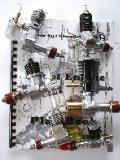 Les also supplied this shot which The Boys and I take as a tribute. It features the Motor Boys Plans Book, posed with the engines Les has built from our plans (so far). All Les' engines have his trademark "show quality" finish, and while it might not be 'original' it sure is eye-catching, which is just what you need at a show. The secret of producing a show-quality finish, Les says, is build a clean engine, then apply simple, plain, old fashioned, elbow grease! Left to right, top to bottom thay are
Les also supplied this shot which The Boys and I take as a tribute. It features the Motor Boys Plans Book, posed with the engines Les has built from our plans (so far). All Les' engines have his trademark "show quality" finish, and while it might not be 'original' it sure is eye-catching, which is just what you need at a show. The secret of producing a show-quality finish, Les says, is build a clean engine, then apply simple, plain, old fashioned, elbow grease! Left to right, top to bottom thay are
 The Gotham Hobby Deezil
The Gotham Hobby Deezil
 The M&M 29
The M&M 29
 The "Scrapper" 29 ignition
The "Scrapper" 29 ignition
 NOVA-1 4.5 cc diesel
NOVA-1 4.5 cc diesel
 The Owen Mate 2 cc DIY diesel
The Owen Mate 2 cc DIY diesel
 The Vivell 09 RRV diesel
The Vivell 09 RRV diesel
First of the New Pepperells
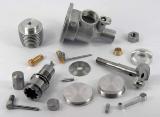
Continuing with the monthly Pepperell fixation, Ken Croft has completed his version of the "Seven-Sixteenths" engine from Eric's case casting, parts for which are shown here—with picture by Ken naturally, and well up to his usual standard of building and photography. The only deviations from the original (as drawn by me from the engine in David Owen's collection) were bushing the shaft, the use of a split collar for the prop driver, and a slightly smaller diameter on the cooling head to fit available stock. In the former cases, quite sound modifications (though the smaller shaft required some adjustments to preserve the timing), and in the letter, if he hadn't told us, nobody would have noticed.
 The engine started up readily, despite Ken's initial trepidation regarding the Pepp's peculiar air valve and fixed fuel jet. Figuring it's easier to make the jet larger than smaller, Ken initially reduced it from the 0.015" I'd measured to 0.008". Initial runs showed that this jet was too small as the best running position was with the air valve near closed. Opening out the jet to the full 0.015" allowed the engine to run better, but with the air valve now fully open, but it was mysteriously prone to flooding and stopping. Ken diagnosed this as leakage of raw fuel from the integral tank around the inner backplate, assisted by the pump action within the crankcase. Fitting a gasket cured this little problem, though making that gasket was a fiddly job; an O ring would probably be a better solution and that's what my Pepps—now under construction—will get.
The engine started up readily, despite Ken's initial trepidation regarding the Pepp's peculiar air valve and fixed fuel jet. Figuring it's easier to make the jet larger than smaller, Ken initially reduced it from the 0.015" I'd measured to 0.008". Initial runs showed that this jet was too small as the best running position was with the air valve near closed. Opening out the jet to the full 0.015" allowed the engine to run better, but with the air valve now fully open, but it was mysteriously prone to flooding and stopping. Ken diagnosed this as leakage of raw fuel from the integral tank around the inner backplate, assisted by the pump action within the crankcase. Fitting a gasket cured this little problem, though making that gasket was a fiddly job; an O ring would probably be a better solution and that's what my Pepps—now under construction—will get.
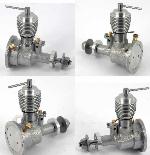 With more time on the engine now, Ken reports that it is an exceptional performer for its age (1946) that would have blown away the comparable English motors of the time. Initial runs tached a Top Flight 10x3.5 wood at 7,200 RPM and an APC GRP 8x4 at 10,400 RPM. After more running it was holding 11,600 RPM on a Top Flight 8x3.5 wood! Especially noteworthy is the smoothness of the run, and the responsiveness to the micky-mouse air valve arrangement. In fact, Ken thinks that the air valve is so reliable that it could be used effectively as an R/C throttle and is now considering which airframe will be most suited to the engine.
With more time on the engine now, Ken reports that it is an exceptional performer for its age (1946) that would have blown away the comparable English motors of the time. Initial runs tached a Top Flight 10x3.5 wood at 7,200 RPM and an APC GRP 8x4 at 10,400 RPM. After more running it was holding 11,600 RPM on a Top Flight 8x3.5 wood! Especially noteworthy is the smoothness of the run, and the responsiveness to the micky-mouse air valve arrangement. In fact, Ken thinks that the air valve is so reliable that it could be used effectively as an R/C throttle and is now considering which airframe will be most suited to the engine.
More Kiwi
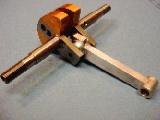
Nick Jones has sent in more photographs of his progress on the ETW Kiwi. This month he has completed the conrod, and photographs of the steps have been added to Kiwi Construction page. As you will no doubt intuit from the photographs, Nick's shop is CNC equipped, as when not being used to make models, it maintains the equipment that runs Nick's business—a most fortuitous arrangement for all concerned.
New Books and Magazines This Month
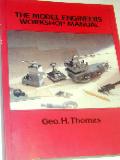
The subject for our book review this month is a relatively old one, but still in print: "The Model Engineers Workshop Manual" by George H Thomas, TEE Publishing (UK), 1992, ISBN 1-85761-000-8, and you'll have to pardon me if I absolutely rave about this book. Although GHT (as he was known to Model Engineer readers) is rightly credited as the author, the book was compiled after his passing by William Bennet, using articles published in the ME and SMEE house magazine. Bennett deserves full credit for this undertaking, and I hasten to add, that unlike some reprinted collections of magazine articles, all those in this book appear to have been reset and laid out to fit the format. Neither do any of the photographs or drawings suffer from the degradation all too frequently apparent in such collections (especially welcome as GHT was a superb photographer and meticulously documented his articles with clear, well posed illustrations). In compiling the material, Mr Bennet and his assistants have adjusted "timing related" issues in the text, edited in appropriate references and cross references, and culled the "Letters" column to ensure we gain the most from GHT's accumulated wisdom.
I'd thought that pages on this web site were liberally littered with references and praise of this book, but the new search facility finds only 6 references to "workshop manual". This is a surprise as this book has been a tremendous assist to my model making. In fact, it was GHT's series on dividing and graduating in some old ME's picked up at a book sale that rekindled by interest in metal work and ended up in my equipping the workshop with the Myford Super 7. This is the same lathe that GHT used and designed so many useful attachments for, all of which, with the exception of the Universal Dividing Head, appear in this volume (the UDH is in a second TEE compilation, together with GHT's "Pillar Tool").
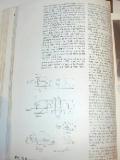
In 303 pages with 197 illustrations spread over 28 chapters and two appendices, GHT covers every conceivable aspect of model engineering as as we knew it in the pre-CNC-for-the-masses days. He presents detailed designs and construction sequences for a broad spectrum of tools, starting with a simple lathe center height gauge (which I use virtually every day), to Bending Rollers, tool holders, and modifications to the Myford itself. While several of the accessories are "tightly coupled" to the ML7, all can be adapted to other lathes with varying degrees of ingenuity. The sample page here shows the drawing for the 3/16" HSS round tooling holder that I use for cutting cylinder head fins—another tool from this book that I'd be totally lost without.
Not all chapters in the book are devoted to concrete items. Many consider common tasks such as parting, boring, taper turning, thread cutting, the use of milling cutters, etc, etc, giving extremely insightful discussions and techniques that will make any model engineer's life easier. For instance, in Chapter 12 he describes two ways to cut threads by setting over the topslide. The results obtained by the star turner's method are so easy and superior, that one would need a very good reason to use any other method. Couple this method with his Retracting Toolholder for screwcutting from the previous chapter, or the modification to the Myford topslide in Chapter 17, and threadcutting becomes an absolute pleasure.
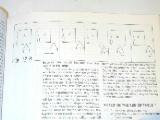 Briefly, in this approach, the topslide is set over by a little more than half the thread angle (for male threads), and the work touched with the cutter tip (A and B). With both dials zeroed, the cross slide is then used to advance to the full depth of cut, then locked in that position (C). Since the top slide dial was zeroed in (A), it must now be withdrawn (D) and the thread progressively cut with the tool chasing down the flank, resulting in a steady cutting force—rather than the progressively increasing one experienced when a "plunge cut" is used. The thread is complete when the top slide dial again reads zero. There's more to it than that, but those are the essentials.
Briefly, in this approach, the topslide is set over by a little more than half the thread angle (for male threads), and the work touched with the cutter tip (A and B). With both dials zeroed, the cross slide is then used to advance to the full depth of cut, then locked in that position (C). Since the top slide dial was zeroed in (A), it must now be withdrawn (D) and the thread progressively cut with the tool chasing down the flank, resulting in a steady cutting force—rather than the progressively increasing one experienced when a "plunge cut" is used. The thread is complete when the top slide dial again reads zero. There's more to it than that, but those are the essentials.
Although GHT never dabbled in IC engine making (as far as I'm aware), no model engineer should be without this book on their shelf, regardless of their skill and experience level. I simply can't recommend any book on the subject higher than this one.
Engine Of The Month:Mills 1.3 Mk 1
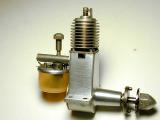
The venerable Mills 1.3 appeared on the UK market in 1946 and sold by the thousands. The Engine Finder has had a picture of the Mills available since day-one, and the literature has effectively done this engine to death, hence this month's review is more on the lines of a collected bibliography than anything else. Still, it's a landmark engine that has been the subject of more than one reproduction effort over the years. So click on the Mills 1.3 link to read the long overdue expansion of coverage devoted to the Mark I version of the engine.
Tech Tip of the Month: Cooling Head Fins

Machining the cooling fins on a cylinder head is not that tricky, although doing it well requires a bit of extra effort—and that is the subject for this month's Tech Tip, which you will find by clicking on the picture—or by going to the new Techniques Index Page. In recent months, I've frequently embedded the Tech Tip in the monthly news page. This change to ensure separation is a result of reader feedback, coupled with my own desire to improve the general site layout and navigation. So expect shorter, more tightly focused pages, but more of them!
New Gallery Page
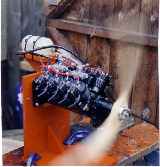
An email from Ron and Bob Lane in England has caused a new page to be added to The Gallery. The breadth of their work is most impressive, spanning two-strokes to gas turbines, with all sorts of multy-cylinder 4-strokes in between. At the moment, Page 4 of the Gallery contains only pictures and words of the Lane Brothers' engines, but I've got more shots from them of Continental model engineering that will be added when time permits.
Ivor F's Auction
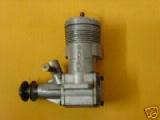 Way, way back in the May 2003 Issue of Model Engine News, I reported on a newspaper item stating that Australian aeromodeling icon, Ivor F, would be disposing of part of his model engine collection for philanthropic reasons. An email received this past month informs me that this is about to take place on eBay over the coming weeks. The engines will appear with fvh1 as the user name and while I was tempted for a moment to keep this news to myself
Way, way back in the May 2003 Issue of Model Engine News, I reported on a newspaper item stating that Australian aeromodeling icon, Ivor F, would be disposing of part of his model engine collection for philanthropic reasons. An email received this past month informs me that this is about to take place on eBay over the coming weeks. The engines will appear with fvh1 as the user name and while I was tempted for a moment to keep this news to myself  , that would not be cricket. Besides, the word will get out anyway—so happy bidding, and remember, you are not making Ivor F rich, you're contributing to the education of potential modelers!
, that would not be cricket. Besides, the word will get out anyway—so happy bidding, and remember, you are not making Ivor F rich, you're contributing to the education of potential modelers!
Pssst

No. I absolutely refuse to apologize for my cryptic and frequently irreverent news item titles. Apart from being one of my few pleasures, they qualify me for full membership in the local chapter of the Sad Geezers Society. In this case, the tenuous connection lies in another addition to The Gallery, namely the engine component of a flash steam power plant for model aircraft, believed to be the genuine original engine built by English model aircraft pioneer, HH Groves and detailed in the pages of the Model Engineer and Electrician in 1913. Click the pic for more photos and details.
 Search Me
Search Me
 Son of EZE
Son of EZE
 Stoned
Stoned
 First of the New Pepperells
First of the New Pepperells
 More Kiwi
More Kiwi
 New Gallery Page
New Gallery Page
 Ivor F's Auction
Ivor F's Auction
 Pssst
Pssst
 Editorial
Editorial
 New Books and Magazines This Month
New Books and Magazines This Month
 Engine Of The Month: Mills 1.3 Mk 1
Engine Of The Month: Mills 1.3 Mk 1
 Tech Tip of the Month: Cooling Head Fins
Tech Tip of the Month: Cooling Head Fins
 Standard Stuff
Standard Stuff





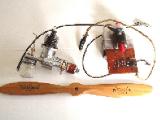

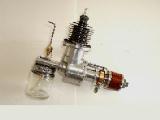












 Way, way back in the
Way, way back in the  , that would not be cricket. Besides, the word will get out anyway—so happy bidding, and remember, you are not making Ivor F rich, you're contributing to the education of potential modelers!
, that would not be cricket. Besides, the word will get out anyway—so happy bidding, and remember, you are not making Ivor F rich, you're contributing to the education of potential modelers!
